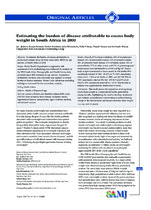Estimating the burden of disease attributable to excess body weight in South Africa in 2000
Abstract
OBJECTIVE: To estimate the burden of disease attributable to
excess body weight using the body mass index (BMI), by age
and sex, in South Africa in 2000.
DESIGN: World Health Organization comparative risk
assessment (CRA) methodology was followed. Re-analysis of
the 1998 South Africa Demographic and Health Survey data
provided mean BMI estimates by age and sex. Population attributable
fractions were calculated and applied to revised
burden of disease estimates. Monte Carlo simulation-modelling
techniques were used for the uncertainty analysis.
SETTING: South Africa.
SUBJECTS. Adults ≥ 30 years of age.
OUTCOME MEASURES. Deaths and disability-adjusted life years
(DALYs) from ischaemic heart disease, ischaemic stroke,
hypertensive disease, osteoarthritis, type 2 diabetes mellitus,
and selected cancers.
RESULTS: Overall, 87% of type 2 diabetes, 68% of hypertensive
disease, 61% of endometrial cancer, 45% of ischaemic stroke,
38% of ischaemic heart disease, 31% of kidney cancer, 24% of
osteoarthritis, 17% of colon cancer, and 13% of postmenopausal
breast cancer were attributable to a BMI ≥ 21 kg/m2. Excess
body weight is estimated to have caused 36 504 deaths (95%
uncertainty interval 31 018 - 38 637) or 7% (95% uncertainty
interval 6.0 - 7.4%) of all deaths in 2000, and 462 338 DALYs
(95% uncertainty interval 396 512 - 478 847) or 2.9% of all
DALYs (95% uncertainty interval 2.4 - 3.0%). The burden in
females was approximately double that in males.
CONCLUSIONS: This study shows the importance of recognising
excess body weight as a major risk to health, particularly
among females, highlighting the need to develop, implement
and evaluate comprehensive interventions to achieve lasting
change in the determinants and impact of excess body weight.

